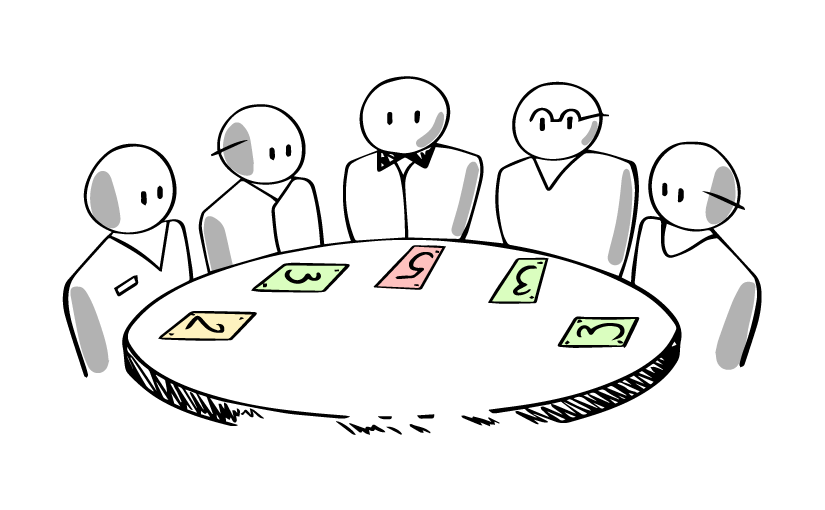Planning Poker, also known as Scrum Poker, is a collaborative estimation technique used by Agile teams to determine the effort or complexity of tasks in a project. It is a consensus-based method that promotes discussion, encourages participation, and ensures that all team members contribute to the decision-making process. By using Planning Poker, teams can create more accurate and realistic estimates for their work, which leads to better planning and execution.
The Basics of Planning Poker
Planning Poker revolves around estimating tasks in terms of story points, ideal days, or any other unit of measure that fits the team’s context. The goal is to assign a numerical value to each task, representing its relative size, complexity, or effort required.
Components of Planning Poker
- Planning Poker Cards: Each participant is given a set of cards, either physical or digital. These cards typically display numbers from a predefined sequence, such as the Fibonacci sequence (e.g., 1, 2, 3, 5, 8, 13, 21), T-shirt sizes (e.g., XS, S, M, L, XL), or custom scales.
- The Backlog: The product backlog contains the tasks or user stories that need to be estimated. These are typically prepared by the Product Owner ahead of the Planning Poker session.
- The Team: All members of the Agile team participate in the session, including developers, testers, designers, and any other roles involved in delivering the work. The Product Owner may also participate to clarify requirements but does not influence the estimates.
How Planning Poker Works
- Preparation: Before the session, the Product Owner prioritizes and prepares a list of user stories or tasks to estimate. Each task should be clearly defined with acceptance criteria and any necessary context.
- Discussion: The Scrum Master or facilitator presents the first task to the team. The Product Owner answers any questions to ensure everyone understands the task.
- Estimation:
- Each team member selects a card that represents their estimate for the task.
- The cards are placed face-down to avoid influencing others.
- Reveal:
- Once all participants have chosen their cards, they are revealed simultaneously.
- If everyone selects the same value, that estimate is recorded.
- If estimates vary, the team discusses the differences. Participants explain their reasoning, often uncovering overlooked complexities or dependencies.
- Re-estimate:
- After discussion, the team re-estimates the task until consensus is reached or the estimates converge.
- Repeat: The process continues for each item in the backlog until all tasks have been estimated.
Why Use Planning Poker?
Planning Poker is widely adopted because it addresses common challenges in task estimation, such as bias, lack of clarity, and uneven participation. Here are some of its key benefits:
- Promotes Collaboration: Encourages open discussions, ensuring that everyone’s perspective is considered.
- Uncovers Risks: Highlights uncertainties and risks early, helping teams address them proactively.
- Improves Accuracy: By leveraging the collective intelligence of the team, estimates become more realistic and reliable.
- Builds Consensus: Ensures alignment among team members on the scope and effort required for tasks.
- Enhances Engagement: Keeps team members actively involved in the estimation process.
When to Use Planning Poker
Planning Poker is best used during sprint planning sessions or backlog refinement meetings when the team needs to estimate upcoming work. It is particularly effective for:
- Complex Tasks: When a task requires input from multiple team members to fully understand its scope.
- New Teams: For teams that are still forming and need a structured method to estimate collaboratively.
- Distributed Teams: Digital Planning Poker tools make it easy for remote teams to participate in real-time.
Tools for Planning Poker
With the rise of distributed teams, having the right tool for Planning Poker can make all the difference. Planning Poker Agility is the ideal solution for modern Agile teams. Here’s why:
-
Free and Unlimited Use: No restrictions on how many sessions you can run.
-
Instant Setup: Start estimating with one click; your session is ready in seconds.
-
Real-Time Voting: Teams can estimate simultaneously, with results shown only after everyone has voted, ensuring unbiased collaboration.
-
Adaptable Estimation Options: Choose from Fibonacci, Time-based, or custom values to fit your team’s workflow.
-
Automated Reveal: Estimates are automatically revealed once all team members have cast their votes, streamlining the process.
-
Integrated Backlog Prioritization: Reorder issues effortlessly by dragging and dropping in real-time, directly within the session.
-
Easy Issue Access: View and edit issues directly within the tool, keeping everyone aligned and focused.
Unlike other tools, Planning Poker Agility is fully integrated with Jira, offering seamless interaction with your project backlog. By choosing Planning Poker Agility, teams gain a fast, interactive, and efficient estimation experience designed for simplicity and real-time collaboration.
Get started with Planning Poker Agility today and transform your backlog estimation sessions!
Final Thoughts
Planning Poker is more than just a method for estimating work; it’s a team-building exercise that fosters communication, collaboration, and alignment. By using Planning Poker, Agile teams can tackle the complexities of estimation with confidence and set themselves up for successful project delivery.


4 Comments
Steven Marlow
Love the content, I agree in my experience relative estimation definitely beats absolute.
Joan
Agree with using Fibonacci sequence, it bakes in the hidden complexities in software development which is often missed/overlooked.
Dillon Karadia
Used Planning Poker Agility with dozens of teams and they all loved it!
Stanley
It was useful to know why to use fib sequence when estimating, thanks!